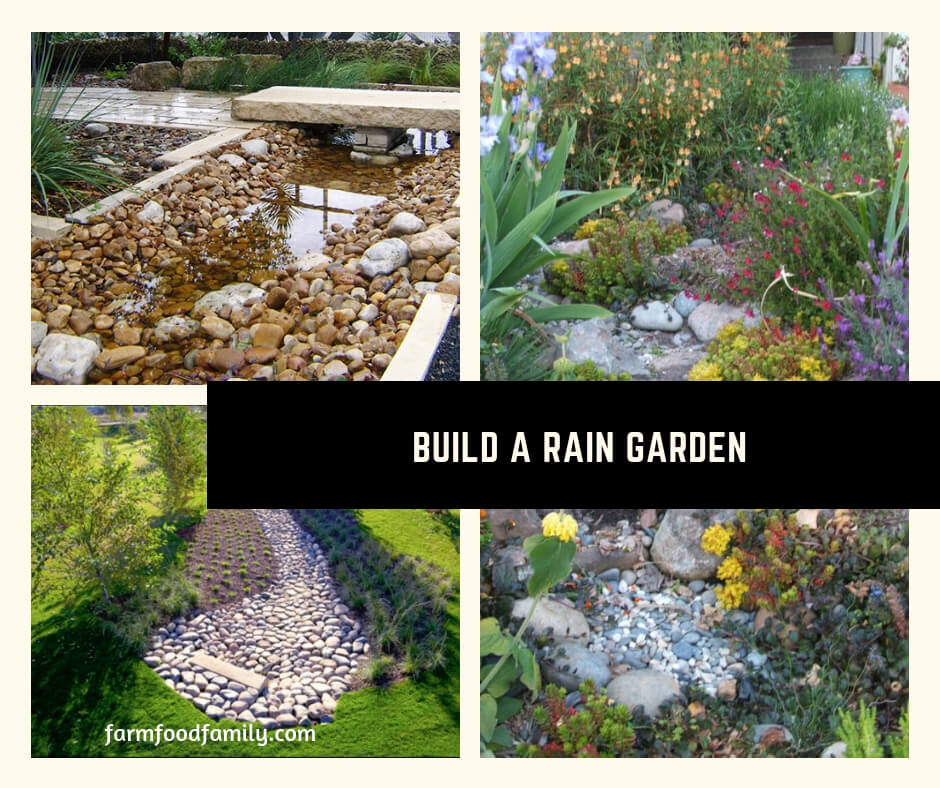Sometimes runoff water from impervious surfaces will concentrate and cause erosion problems. Rain gardens harvest this water, filter pollutants, and prevent erosion.
Properly designed, rain gardens intercept the natural water flow and slow it down, allowing it to gradually infiltrate into the ground.
Rain Gardens are Functional

Sustainable gardeners appreciate how rain gardens work to preserve the water quality of streams and lakes by reducing erosion, filtering pollutants, and recharging groundwater.
They’re also attractive additions to a yards. They don’t need irrigation, require less maintenance than lawns, provide year-long color and texture, and attract birds and butterflies. Rain gardens are environmental work horses that please the eye and soothe the soul.
Building the Rain Garden
Rain gardens are easy to build. Tools needed: a pick and shovel for digging, and a tarp and wheelbarrow for dirt control.
Use water draining from hard surfaces – roofs, driveways, or patios – to supply the rain garden. Determine where the water exits these surfaces. Follow its flow path to a location almost level or slightly depressed.
Don’t build the rain garden close to foundations, or where the water table is within 24″ of the soil surface. Keep it off septic tanks and leach fields, and away from steep slopes.
Next, size the rain garden based on the square footage of the area draining to it. Any combination of surfaces (ground, paved, tiled or shingled) that directs water to the garden site is the drainage basin for that garden.
Water from roofs will exit at downspouts and flow to the garden spot. Add the roof square footage that contributes to this downspout to the total drainage area for that particular garden spot. Use this figure to size the garden.

Infiltration and Soil Type
Soil type is critical for proper sizing. Clay soils infiltrate water slowly. Size rain gardens in clay at 60% of the drainage area. Sandy soils allow rapid infiltration. They can be 20% of the area.
Depending on how fast water infiltrates, size loamy soils between 20% and 60% of the drainage area. For rain gardens exceeding 300 sq.ft., consult a garden designer or landscape architect for proper sizing.
Rain Garden Layout and Excavation

Define the rain garden by laying out a curvilinear pattern, using rope, a garden hose, or surveyor’s paint.
Remove the soil so the deepest part of the rain garden is 8-10″ deep. Place excavated dirt on the tarp to keep grass clean and for easier handling.
Level the garden’s bottom. Fill the wheelbarrow with dirt and roll it to the garden’s downhill side. This dirt is for the dam. The top of the dam should not be higher than the garden’s uphill side (about 12″).
Rain gardens should hold no more than 6″ of water above the ground surface. Add an overflow path for water to take when large rainfalls exceed the garden’s capacity.
Plants and Soil Help Filter Pollutants
Mix 3″ of organic compost into the soil in the bottom of the garden. The soil should have a neutral pH. Proper drainage is a must to allow infiltration. For soils with high clay content, remove 1-2′ and replace with a mixture of 50-60% sand, 20-30% topsoil, and 20-30% compost.
Plant a grass strip on the upper edge of the garden to slow runoff. Stabilize the dam with grass. Use a mix of ornamental grasses, shrubs, and self-seeding perennials in the garden, both drought and moisture tolerant plants.
Contact county extension agents or botanical gardens for regionally compatible plants.
Tuck a 3″ layer of mulch around the plants. Use pine straw or shredded hardwood – pine bark tends to float away. Add a layer of newspaper before mulching to control weeds. Don’t use a commercial weed barrier – they may contribute to shallow root growth and matting within the mulch layer.
Rain Garden Maintenance
Watch for weeds that get past the newspaper, and remove them promptly. Add mulch as needed. Rain gardens will be relatively low maintenance if the right plants are used.
Deadhead perennials, and cut them back according to the needs of the species. Shear ornamental grasses at winter’s end – they’ll easily recover, and fill out by summer.
A rain garden is a fine addition to any property. These guides will ensure the rain garden does its job – controls runoff, cleans water for re-use – and gives pleasure for years to come.


